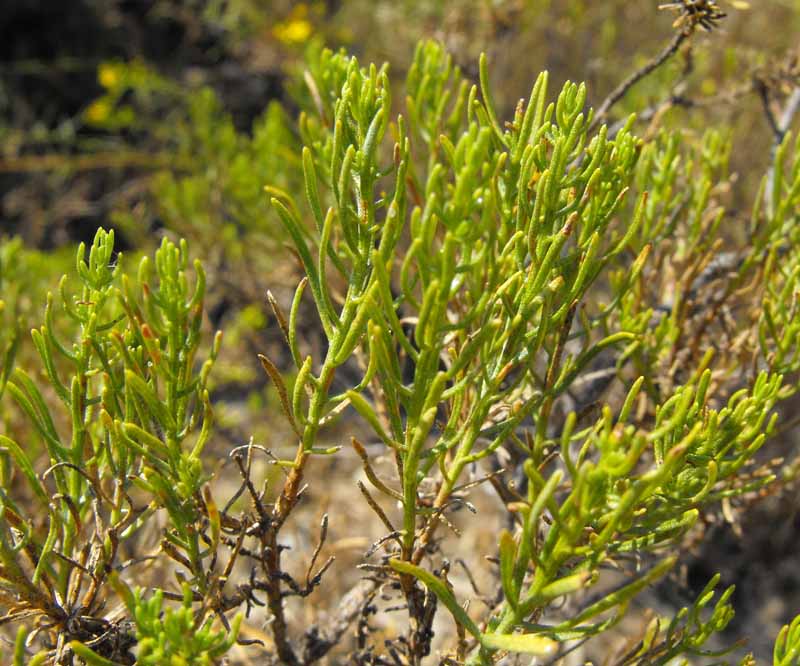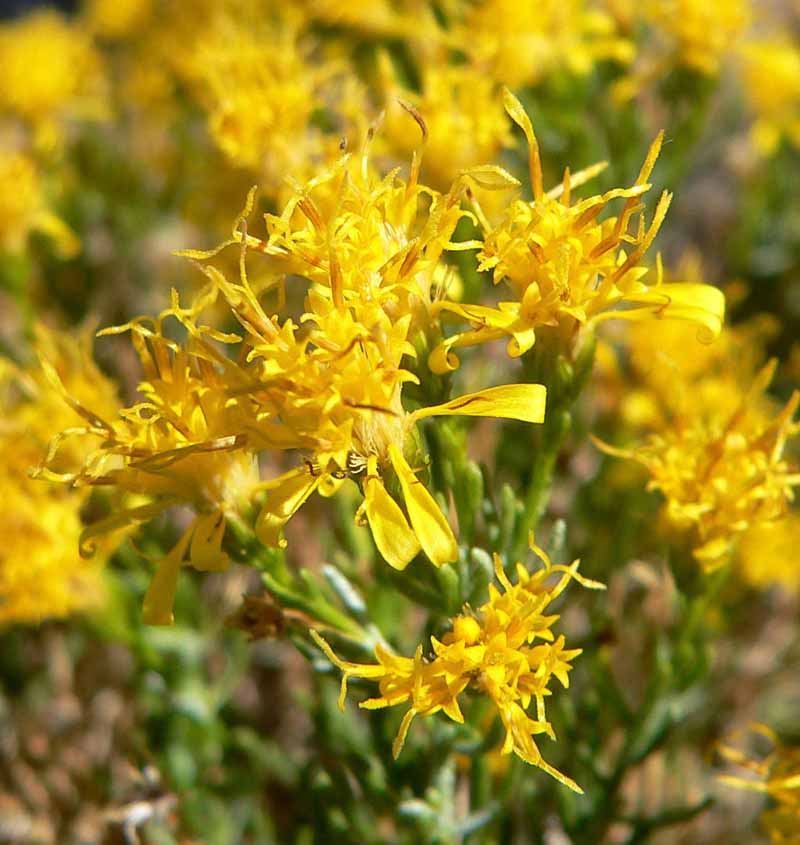And in addition to tolerating blistering desert heat, this tough evergreen shrub can also withstand temperatures as low as 10°F. Perfection! Before we get too far, I know you’re wondering how the heck Ericameria laricifolia got its common name. Its foliage is covered in a resin that, when touched, smells like the stinky solvent. We link to vendors to help you find relevant products. If you buy from one of our links, we may earn a commission. Other names for this desert beauty include turpentine brush, narrowleaf goldenbush, larchleaf goldenweed, and in Mexico, aguirre. It was previously known scientifically as Haplopappus laricifolia, and many people continue to refer to it as simply “haplopappus.” As the plant ages, its lower stems may drop their leaves and become bare, but the upper stems are covered in dark green, needle-like — but soft— leaves. In early autumn, the plant bursts into clouds of yellow flowers featuring attractive, straplike petals that wiggle out from a center cluster of smaller flower forms. The yellow flowers morph into white, dandelion-like balls of fluff, and then fade to tan seed heads, providing a long period of landscape loveliness.
Cultivation and History
As we mentioned, this long-lived plant is found natively in southwest desert topographies including mesas, slopes, and canyons. While it is native to elevations of 3,000-6,000 feet, it does well at lower elevations, also. While it has not yet been widely adapted into landscape use, native plant aficionados often highlight it as an excellent choice for regional xeriscape gardens, and it is slowly gaining wider adoption.
Propagation
Place seeds in the refrigerator for about two months before you plan to germinate them. Fill seed trays with a seedling mix and place seeds on top of the soil, and keep consistently moist. Once you see germination beginning — seven to 10 days — cover seeds with a light layer of the seedling mix. Once your seedlings are three to four inches tall, and outdoor nighttime temperatures are in the mid-fifties, you can transplant your seedlings outdoors. Water every other day for the first couple weeks, and then you can gradually reduce your watering as your plants grow bigger and stronger.
How to Grow
In lower elevations, plant turpentine bush in spring or fall; in higher elevations you’ll want to plant in spring only. This daisy family member needs 100% full sun to be at its best. It can get unattractively leggy in part-shade conditions, and it doesn’t bloom as well in shady spots, either. Ericameria laricifolia prefers poor, dry, sandy soils that don’t have a lot of organic materials. Limestone-rich soils are fine too. Water young plants weekly until established, and then water monthly. Too much water will reduce blooming.
Growing Tips
Plant in full sun Don’t amend the soil with organic material Water sparingly once established
Pruning and Maintenance
In winter, you can trim off the scruffy-looking seed heads if you like a tidy appearance. To reinvigorate an older plant and encourage an attractive, mounded form, trim the plant back to within a few inches of the ground in early spring. There’s no need to fertilize turpentine bush.
Where to Buy
Turpentine bush can be, admittedly, a bit tricky to find for purchase. If you live in the Southwest, you may be able to find it at a garden center that specializes in native plants.
Managing Pests and Diseases
Lucky you! You’ve picked a beautiful shrub that has no known pest or disease problems.
Best Uses
This plant is slightly more flammable than many plants, so it is recommended that it be kept at least 15 feet away from structures. It makes a nice specimen plant, or you can plant as a hedge or in other mass groupings. It is perfectly suited to a xeriscape landscape.
Quick Reference Growing Guide
In Celebration of Hot Days and Cool Nights
Mother Nature’s biodiversity is truly magnificent. While the rain-soaked bits of our planet are hailed for their lush and glittering flora, the drier areas, too, are resplendent in ways perhaps less heralded but certainly no less spectacular. Turpentine bush — despite its less-than-glamorous moniker — is a brilliant example of the diverse glow of the desert. Its deep green, needle-like leaves and radiant yellow flowers add a punch of loveliness to the Southwest, whether on the wild slope of a ravine or in a home gardener’s carefully tended landscape. Looking for more planting options suitable for hot climates? Check out these guides:
How to Grow and Care for Salvia Frilly, Pink, and Easy to Grow: Chinese Fringe Flower Easy Landscaping with Ornamental Grasses: Simple Tips for Carefree Success




